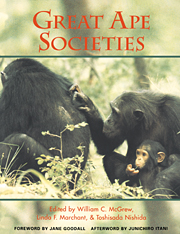Book contents
- Frontmatter
- Contents
- List of contributors
- Preface
- Foreword: conserving great apes
- Part I Apes overviewed
- Part II Social ecology
- Part III Social relations
- 8 Social grouping in Taï chimpanzees
- 9 Coalition strategies among adult male chimpanzees of the Mahale Mountains, Tanzania
- 10 Male rank order and copulation rate in a unit-group of bonobos at Wamba, Zaïre
- 11 Comparing copulations of chimpanzees and bonobos: do females exhibit proceptivity or receptivity?
- Part IV Minds
- Part V Apes compared
- Part VI Modeling ourselves
- Afterword: a new milestone in great ape research
- Appendix: great ape study sites
- Index
8 - Social grouping in Taï chimpanzees
Published online by Cambridge University Press: 04 August 2010
- Frontmatter
- Contents
- List of contributors
- Preface
- Foreword: conserving great apes
- Part I Apes overviewed
- Part II Social ecology
- Part III Social relations
- 8 Social grouping in Taï chimpanzees
- 9 Coalition strategies among adult male chimpanzees of the Mahale Mountains, Tanzania
- 10 Male rank order and copulation rate in a unit-group of bonobos at Wamba, Zaïre
- 11 Comparing copulations of chimpanzees and bonobos: do females exhibit proceptivity or receptivity?
- Part IV Minds
- Part V Apes compared
- Part VI Modeling ourselves
- Afterword: a new milestone in great ape research
- Appendix: great ape study sites
- Index
Summary
INTRODUCTION
Why do animals live in groups? Generally, animals are thought to live in groups in order to increase their survival and reproductive success. But group living incurs costs, mainly in terms of higher intraspecific competition and higher risks of parasite transmission. Therefore, the discussion has focused around the benefits that could make possible the evolution of sociality. Three main benefits have been proposed; group living decreases predator pressure (van Schaik, 1983; Dunbar, 1988), allows better exploitation and protection of food resources (Wrangham, 1980; Krebs & Davies, 1993), or results from the need for cooperative behavior, like hunting or communal breeding (Caraco & Wolf, 1975; Emlen, 1991). For more specific situations, other factors have been proposed such as rearing strategies (e.g. lions; Packer et al., 1990). In most cases, observers study animals that already live in groups, making it difficult to investigate the factors that were originally responsible for the appearance of social groups. However, we can study the factors that affect the social groups that we observe in the wild.
Predation pressure has been shown to have a large impact on group size in many animals including species of fish, birds, ungulates and primates (Pulliam & Caraco, 1984; Kummer et al., 1985; Cheney & Wrangham, 1987; Dunbar, 1988; Krebs & Davies, 1993). Similarly, seasonal variation in food supply has been shown to have a marked influence in the fragmentation of hamadryas, olive and gelada baboons and of spider monkeys (Kummer, 1971; Dunbar, 1988; Chapman et al., 1995).
- Type
- Chapter
- Information
- Great Ape Societies , pp. 101 - 113Publisher: Cambridge University PressPrint publication year: 1996
- 103
- Cited by

